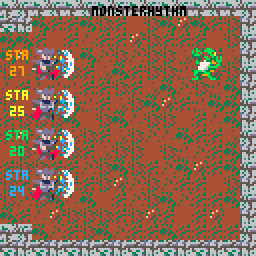(Original post at Ludum Dare website blog here)
This is the postmortem for the game I made in two days for the Ludum Dare 33. The game is called “Monsterhythm”. You can find the Ludum Dare entry page here and you can play it here.
As a first game jam experience, it have been (really) great. The other jammers were very supportive, and you could breath the creativity and positiveness around. I’m sure I will join a game jam again in the near future.
About the game itself, overall I’m quite happy with the results I got. People liked the game, and it got a solid three stars in all the categories (except Audio):
Seeing it now, it is quite remarkable I managed to end the game. Lot of things went wrong.
Things that went wrong
- Working with a tool and a language without any previous experience. So far, my knowledge is limited to iOS (Objective-C and SpriteKit), but since a game developed on that platform is not shareable, I had to choose between the new Pico-8 (Lua) or Unity (C#).
I chose the former because it looked pretty easy (and it is), but there were two downsides: first, there is almost no documentation about how to work with it (except the superb Pico-8 fanzine); and second, I had zero experience with anything different than SpriteKit (or Cocos2D for that matter).
The result: I used the whole Saturday only to get a shallow understanding of how Pico-8 and Lua works. No progress whatsoever. By the end of the day, I was resolved to stop, because what I learned so far wasn’t enough to program the game I had in mind. Basically, I knew how to deploy a sprite, but not how to destroy it (yes, yes, I know).
After getting a good sleep, I decided that instead of deploying the magic fireballs and destroying them once out of the screen, I will move them normally and then put them back to the starting point once is needed. That decision made the game possible, in the end: it was ugly, and the game was not exactly what I had in mind (several slower fireballs VS only one fast fireball), but it worked. - Sound didn’t feel right: This is quite bad, because it goes against the name and the theme of the game. My idea was to assign a different drumbox sound for each magician (the upper magician is a kick, the second a snare, and so on), and a musical sound the monster. I was expecting that deploying an interesting attack pattern for the enemies, plus the movement of the monster would produce automatically something nice to hear. I was wrong. It (somehow) works, but it doesn’t feel right, and the problem is I can’t imagine how to make it work. Again, my lack of experience (with sound design, in this case) played against myself.
- Not leaving enough time for polishing the experience: although my idea was to prepare a nice pattern (after that, that pattern is what define this game), I didn’t had enough time left. The result: a game too hard from the very beginning. The entry barrier is too high for almost any player (even the more skilled ones), and that made a lot of people leave the game too early. A slower start and a crescendo would have been much, much better.
What went right
- Choosing a known game design. Monsterhythm is very similar to my other game, Phobos Children: a pattern of orbs move through the screen, and you have to do something with them (clear them by groups of three on Phobos Children, in Monsterhythm just avoid them). I knew how to program that (because I did it before), and it allowed me to guess how the gameplay will feel once finished (in the end it’s very similar to a Game&Watch, so it’s easy to grasp by anyone).
- Choosing Pico-8 for the development. Very easy, very fast to work with, powerful in its own way and shareable, I just can say: go and buy it.
- The theme itself. I tried to make something visually similar to a Japanese RPG with some twists, and I think that connected with the players. The dancing monster got a lot of good words in the comments. The game looks nice, but this, more than anything, is a merit from Pico-8 palette and their limitations. Almost anything looks cute there.
- The stamina counter for the enemies. It gives a final goal to the player, and a idea of how much time is left to the end. Also, showing the time after dying gives the player a reference to surpass for the next play.
- I limited the scope to the very minimum. No intro, no ending (but a “You Win” banner), nothing out from the game itself. That allowed me to reach the next bullet point:
- I finished the game! Really proud of this one. It works giving a complete experience to the player. Although too hard, It’s easy to understand and easy to play, and with enough practice is beatable.
How to continue the game
I think Monsterhythm can become a nice free game for mobile devices with some twitches, like a “close call” combo and some extra stages/difficulties (even including a pattern editor on the bundle); but I’ll only continue it if I guess how to work with the sound, since is the main theme of the game. If anybody reading this have any idea regarding the sound design, please contact me through twitter: @danialias.
Thank you for reading, and hope to see you in a future game jam!
Thank you for reading, and hope to see you in a future game jam!
Update: Maybe I should join the October Challenge? :)


